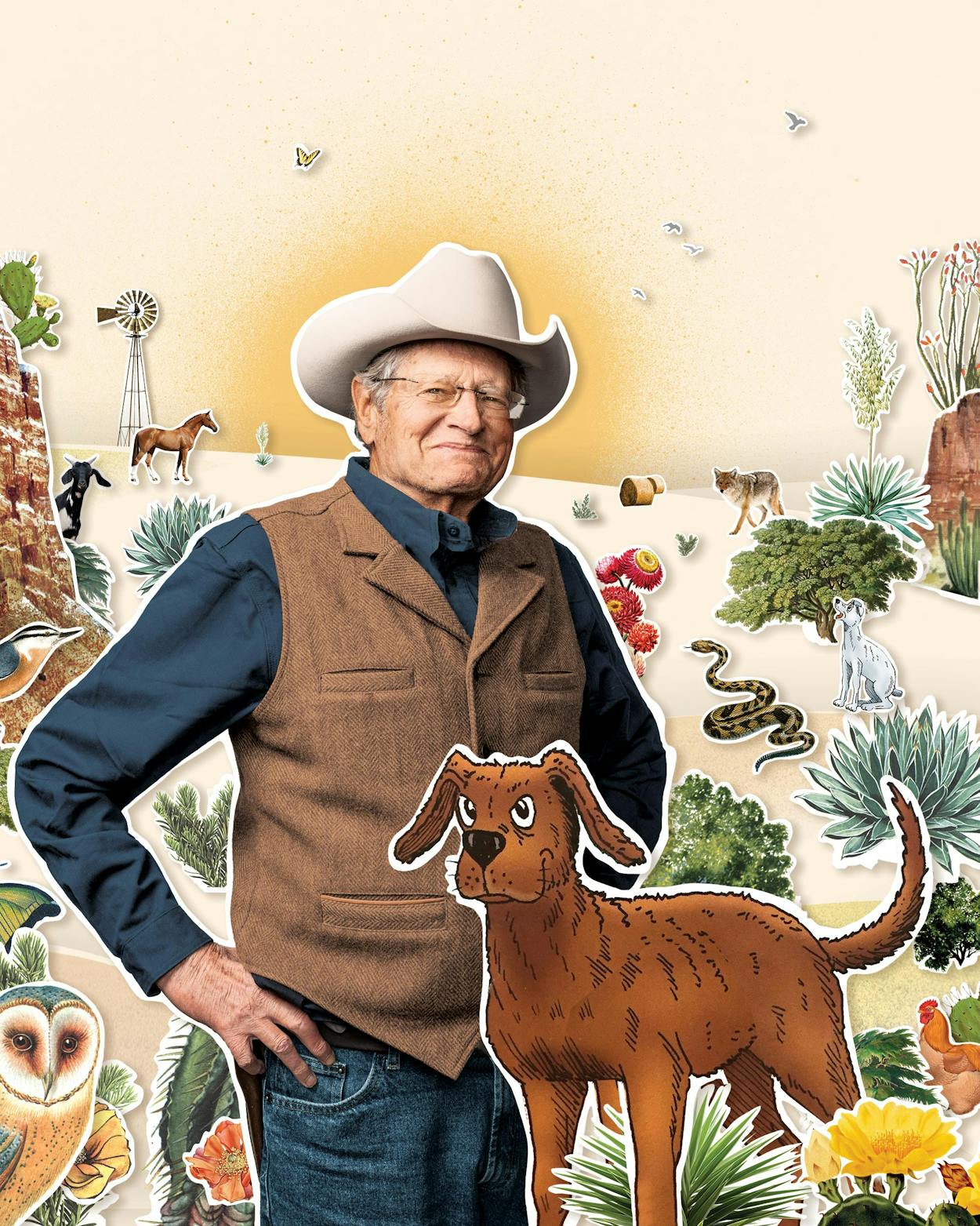Out on the range, rattlesnakes don’t bother John R. Erickson much. They’re a part of life on the M-Cross Ranch, Erickson’s home and working cattle operation, in the rough country of the northeastern Texas Panhandle. But the rattler under the porch of his writing cabin is a different story.
“They’re good at killing mice,” he mutters, grabbing his Ruger .22 pistol. “But they’re also good at killing cowdogs.”
Erickson knows from experience: a few years ago, he lost a pup named Bones to a snakebite. He doesn’t intend to let that happen again. Which is why, one morning in July, the 77-year-old writer lowers himself onto his belly until he is eye level with an unhappy coontail rattlesnake.
Erickson rose early this morning, as he has almost every day for 54 years, to write, or, as he likes to say, “to pull the plow.” At 5:30 a.m. he made the short drive from his house to the one-room cabin that he uses as an office. His headlights shone in the predawn dark, and his two dogs—Rosie, a red heeler bounding with energy, and Daisy, a sweet yellow Lab with an age-stiffened gait—picked their way through tall grass and burned-out cedars alongside the pickup. At the cabin, Erickson made some coffee. Then he got to work.
Some mornings, “work” might mean scribbling replies to fan mail—piles of it—at the folding table that serves as his desk. Other days, he might jot some notes in his journal. But more often than not, he spends the next four or five hours sunk deep into a faded, dust-covered armchair, pecking at the keyboard of his laptop. He works on articles for livestock journals, essays for various websites, and nonfiction books about ranching, cowboying, Texas history, wildfires, and Panhandle archaeology. And twice a year, as the sun eases over the eastern rim of Picket Canyon, Erickson types these words: “It’s me again, Hank the Cowdog.”
That sentence—one of the most compelling in literature to anyone who’s been a third-grader in Texas in the past thirty years—has begun 75 books and counting of the children’s series Hank the Cowdog, which is narrated by an Australian shepherd who tells of his misadventures as the self-deputized head of ranch security. Hank takes the job (and himself) very seriously. But the truth is, he’s often more bluster than brains. “It’s very subtle humor. Half the time the narrator is lying,” Erickson tells me, “and the other half he doesn’t know what he’s talking about because he’s a dingbat.”
When I was growing up in Andrews, in West Texas, Hank was a local celebrity. I remember him keeping watch from posters at my elementary school and at the Andrews County Library. He was a regular passenger on our family road trips. My parents would pop in a Hank audiobook on cassette, and my brothers and I would pause the back-seat bloodshed long enough to laugh at the antics of Hank and his chicken-hearted sidekick, Drover. (Drover’s hoarse-voiced catchphrase, “Oh, my leg!,” which he deploys any time hard work or danger is near, was a running family joke.) When Erickson came to Andrews to give a reading, hundreds packed the amphitheater, braving a lightning storm for the chance to hear him do the voices of all the characters who populated the world he had so vividly imagined: Hank; Drover; Pete the barn cat; Slim Chance, the bachelor cowboy; Rip and Snort, coyote brothers; and Junior, a banjo-picking buzzard.
The books were exciting, chock-full of adventures and capers to crack: Who murdered Sally May’s chickens? Is this corncob truly priceless? Is the moon really made of chopped chicken liver? But more importantly to me, Hank was the only series I had read that was set in my neck of the woods—or rather, my lack of the woods. Growing up surrounded by treeless alfalfa farms and oil fields, I found Hank’s home on a cattle ranch in Ochiltree County a lot more familiar than Narnia or Hogwarts. Reading Hank, I felt for the first time that life in rural Texas could be funny and thrilling and worth writing about. Hank was ours.
Since Hank and Drover made their debut in 1983, the series has sold some 9.5 million copies and continues to be in brisk demand at bookstores and libraries. Hank has been translated into Chinese, Danish, Farsi, Spanish, and, as of last year, Latin. There have been stage, television, and radio adaptations, and whenever Erickson makes live appearances, kids and their parents line up to hear him read from the books and to sing along to the original songs that Erickson writes to go with them. Classics include “Cats Are Stupid,” “Me Just a Worthless Coyote,” and “Never Rope a Cow From the Hood of a Pickup.”
In the early, terrifying days of the pandemic, Erickson’s small team at Maverick Books, the press he owns, uploaded a soothing YouTube video of the author reading from the first Hank book. “The human race has seen some really tough times,” he tells me. “I’m just snowflakes landing on a Sherman tank, but I try to bring light and joy and a sense of order into the little world that I inhabit.”
Hundreds of thousands of listeners turned to Hank for a pandemic distraction late last year, when the cowdog made his podcast debut. With Matthew McConaughey voicing Hank, the Hank the Cowdog podcast climbed to number ten on the Apple podcast charts. Parents tuned in with their kids, hungry for some entertainment that was family-friendly and screen-free.
“I wanted to do the podcast and voice Hank because it’s wily and wholesome at the same time—full of values, common sense, loyalty, and good humor,” McConaughey wrote to me in an email. “Not only do my kids enjoy it, Hank admirers from all over America and especially Texas have reached out to me with collective applause.”
Now, as Hank might say: back to that rattlesnake. On the summer morning when I pay him a visit, Erickson’s writing routine has been interrupted by Rosie and Daisy, who are outside on sniff patrol, sounding the snake alarm. Erickson steps out onto the porch. There is an ominous buzz beneath him: rattler. Daisy is doing her best to evict the intruder, and that makes Erickson nervous.
He unholsters his pistol and eases his way onto the ground. Sweat glistens at his temples, where a nest of unruly gray hair meets his cropped white sideburns. He wears rimless glasses and a faded denim pearl-snap shirt. White chest hairs sprout over the top snap like a bouquet of barbed wire.
The snake’s buzzing sound grows louder. Stretched out flat on the earth, Erickson grips the gun with both hands and leans forward on his forearms to steady his aim. His target is now in a striking position, but Erickson takes his time. He fires two shots. The rattle goes quiet.
He picks himself up and turns to me. “If you can get him out from there,” he says, “you’re welcome to keep him.” (I may have mentioned my fondness for barbecued snake.) I grab a hoe resting against the wall and drag the scaly, ropelike carcass from under the porch. It’s a decent-sized Western diamondback, about four feet long. Erickson’s second shot has nearly taken its head off, and he finishes the job with an Old Timer knife he pulls from his pocket. Then he goes to work burying the head so that Daisy won’t wind up with a surprise from one of the still-loaded fangs.
The day before, when I arrived at the M-Cross, about a hundred miles northeast of Amarillo, Erickson drove out to Hanks Road to guide me the rest of the way to ranch headquarters. (I was glad he did: Hanks Road, an unpaved one-laner, is the last “main” road before a narrower caliche path drops off the caprock into a maze of valleys and mesas.)
When I pulled up to Erickson’s truck, his window was rolled down. Rosie poked her head out, her tongue wagging hello. Seeing the author for the first time with his real-life cowdog brought to mind all those illustrations I had seen of Hank and of Erickson’s fictional alter ego, Slim Chance. Hank’s longtime illustrator, a fellow Perryton native named Gerald L. Holmes, had used Erickson as his model for Slim since he drew sketches for the very first book. Erickson no longer wore the wispy chin whiskers that Slim sports, but his brown eyes and straw hat remained the same.
“Well, c’mon then,” Erickson said after our introductions, adding that his wife Kris had tamales waiting for us back at their house. With that, he was bucketing down the caliche road, Rosie at his side and a cloud of dust trailing him.
It was exactly the kind of scene that fans of the books have spent years imagining when they think of the writer at home—a rancher in his pickup with his cowdog by his side. But such a life wasn’t inevitable. In fact, if things had worked out the way Erickson had hoped they would five decades ago, there would likely be no ranch, no truck, and no Hank.
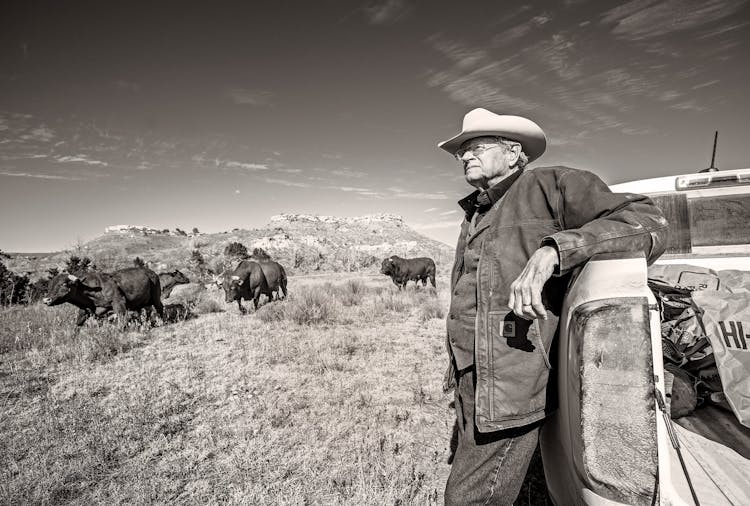
The afternoon of my arrival, once we’ve eaten and Erickson has taken his postprandial nap, we set out for his hometown, Perryton, forty miles north of his ranch and just about spitting distance from the Oklahoma state line. Erickson climbs into his Chevy Colorado, which, beneath a thick coat of red dust, I’m pretty sure is white. Rosie hops in after him, scattering junk mail and empty pouches of Red Man chewing tobacco. A half-filled spit bottle sits in the console. Nothing is out of the ordinary for a truck in rural Texas, with one exception: When Erickson starts the engine, the speakers boom with the sound of, well—
“Morten Lauridsen,” Erickson says. “He writes contemporary choral music.” That’s the last thing I expected to hear, I tell him. “I was listening to Wagner before Bob Wills,” he says—he inherited his love of classical music from his father, Joe. “I don’t like rock and roll. And I hardly listen to the news.” When he’s driving, Erickson is listening either to choral music or to one of the Hank audiobooks, all of which he voices himself. The stories still make him laugh.
In Perryton, he drives down a quiet neighborhood street and parks in front of a yellow two-story house with a concrete porch and brick-red shingles—his childhood home.
He didn’t grow up wanting to be a writer, he says. No famous author had ever sprouted from the fields surrounding Perryton—fields that once gave this corner of the state bragging rights as the “wheatheart” of the country. “It seemed nearly insane to produce a writer in a place with no bookstore,” Erickson says. “We didn’t know it was possible.”
From his mother, Anna Beth Curry Erickson, he inherited a love of storytelling. She would tell him, his older brother, and his younger sister about their family history, which went back five generations in Texas. Some of the tales were gruesome. In 1860, for instance, Erickson’s great-great-grandmother, Martha Sherman, was murdered in a Comanche raid about a hundred miles south of Wichita Falls. Her son, a Shakespeare-quoting cowboy named Joe Sherman, was among the first to run cattle on the Llano Estacado. In 1890, he registered the brand Erickson uses today, the M-Cross. Joe Sherman also met a violent end: in 1917, a neighbor shot him over a disputed watering hole.
His mother’s plainspoken narratives were more interesting to Erickson than the hundreds of books his parents crammed into their home. He was a slow reader, and few authors held his interest. The one exception was Mark Twain. Twain’s novels, especially those featuring Tom Sawyer and Huck Finn, were packed with adventure and wordplay—and, best of all, Twain was funny. Most of the time, Erickson preferred to be playing pirates or Alamo with the neighborhood boys. But his best friend was a mutt named Frisky. “Frisky and I shared a bedroom on the second floor of our old house on Amherst,” Erickson writes in a 2018 book, Finding Hank. “When Frisky and I were alone, I talked to him, just as though he were a person, and felt that he understood and ‘talked’ back with his eyes, ears, and tail.”
As a high school freshman, Erickson started working on a farm and ranch outside Perryton. He learned to brand cattle, fix windmills, and plug his ears with wads of paper to muffle the roar of tractor engines. He wasn’t a brilliant student, but he sang in the a cappella choir, played bassoon in the band, acted in plays, and started at center on the varsity football team. His lanky build—6 feet, 155 pounds—made him an odd fit for the offensive line and earned him a nickname: Slim.
“It was in my senior year that I did my first creative writing and began to suspect that I might have a talent,” Erickson writes in Finding Hank. His English teacher, Annie Love, who had been tasked with making Chaucer palatable to Panhandle footballers, asked each of her students to write an original poem. When Erickson turned in his verse, Love told him it was beautiful and asked him to write more. He spent the rest of the semester staying up late, listening to Bach and scribbling poetry for Love. (Decades later, he would dedicate a Hank book to her.)
But the writing bug didn’t quite stick through his college years. In 1962, he moved away from Perryton for the first time, to attend the University of Denver. There, Erickson threw himself into the civil rights movement. He sold his gun collection to pay for a bus ticket to Mississippi. “It was a pretty scary place to be,” Erickson says, recalling the bullet holes pocking the windows of the Jackson NAACP office. “But it was an opportunity to educate ourselves and maybe put a little pressure on the people who ran the state of Mississippi.” The group of white and Black activists with whom Erickson traveled met both Governor Ross Barnett and civil rights leader Medgar Evers. “That was quite a contrast,” Erickson says. “Medgar Evers was assassinated three months later in his front yard.”
He learned of Evers’s murder while working at a church in East Harlem over summer break. He loved New York City—“with all its noise and soot and shoving crowds, its rainbow of cultures, and the hubris of its architecture,” he would later write—but at the end of the summer, he returned to Texas to begin his sophomore year at the University of Texas, in Austin. He grew his hair and a “defiant little beard.” He traded his denim jacket for a lavender turtleneck and his Wranglers for chinos. He also met Kristine Dykema, a sophomore home economics major from Dallas, at an event for his doomed campaign for a position in the student senate. (A classmate, one Kinky Friedman, also lost his bid that year.) Erickson managed to woo Kris by casting her in a dance drama he had written. “By the time we got that done, Kris’s other boyfriends were getting a busy signal,” Erickson says with a sly grin.
After graduating from UT in 1966, Erickson considered going into the ministry, because he had enjoyed working with underprivileged youths at churches and at the YMCA. But he also felt an intellectual itch. He was accepted into a graduate program at Harvard Divinity School. In Boston he led a bohemian life, subsisting on boiled turkey necks and chicken gizzards (cheap and hearty staples that would show up later in his books as Slim Chance’s primary diet), playing Pete Seeger songs on his banjo, and running around the city with a book tucked under his arm. But Erickson’s life was about to take a turn.
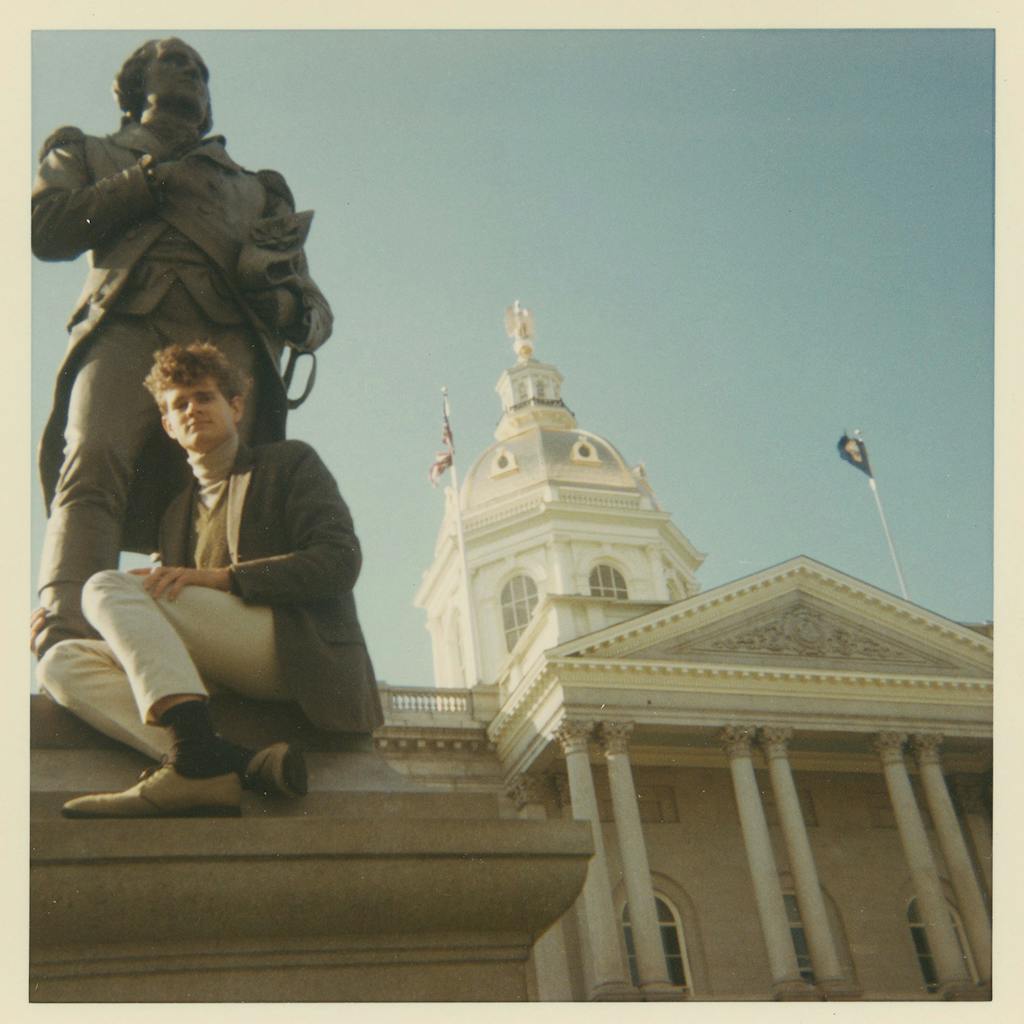
“I heard about this fiction writing course that had a reputation as being the course you wanted to get into, if you could,” Erickson tells me. Recent alumni included John Updike and Norman Mailer. Though Erickson had never taken a fiction class before, he submitted a writing sample and was one of fifteen students admitted. He began to think that writing “was more than a passing fancy.”
Later that year, in August 1967, he married Kris, and she moved across the country to be with him. “All of a sudden, I was no longer a carefree bachelor who could sleep in a dumpster, howl at the moon, stay out all night, and dash off a poem once or twice a month,” Erickson later wrote. “I had joined my life to a woman who had high standards and who expected me to do something with my life.” Although Erickson felt that writing seemed like a “pretty flimsy profession,” he figured he had to give it a shot.
“One of the first decisions I made was, I had better get serious about writing and find out if I can do this or not,” Erickson tells me. “And if Kris had not supported that idea, it never would have happened. But she seemed to have some secret wisdom or knowledge that this was what I was supposed to do.”
One wintry night in 1967, Erickson had an epiphany. He was walking through Harvard Yard. A light snow was falling. He stopped beneath the lamplight and looked around, suddenly aware that he did not and never would belong there. “I had been anxious to get away from the Panhandle and everything it stood for,” Erickson says. “I tried. But then I woke up to the fact that I would never be part of what Harvard was. I had wanted to wash Texas off and be one of those people”—an intellectual who moved through the halls of academe with ease—“but somehow it didn’t work.” Three course hours short of finishing his degree, Erickson and his wife loaded up their belongings and came home to Texas.
Back home in Perryton—a long way from the small independent presses in Austin and far, far from the coastal publishing hubs—Erickson knew he would have to work even harder at his craft to make a living. His ambition only grew. He dreamed of defining a literary generation, like Hemingway or Faulkner had. He chased literary agents around hotel lobbies. He hobnobbed with editors at conferences. He wrote query letters and sent out manuscripts. He was rebuffed at every turn. “I started off pasting my rejection slips on the wall,” Erickson says in a 2016 documentary. “I was confident that by the time I covered one wall, I would get something accepted. Well, when I covered the entire office with rejection slips, it wasn’t funny anymore. So I tore them down and burned them.”
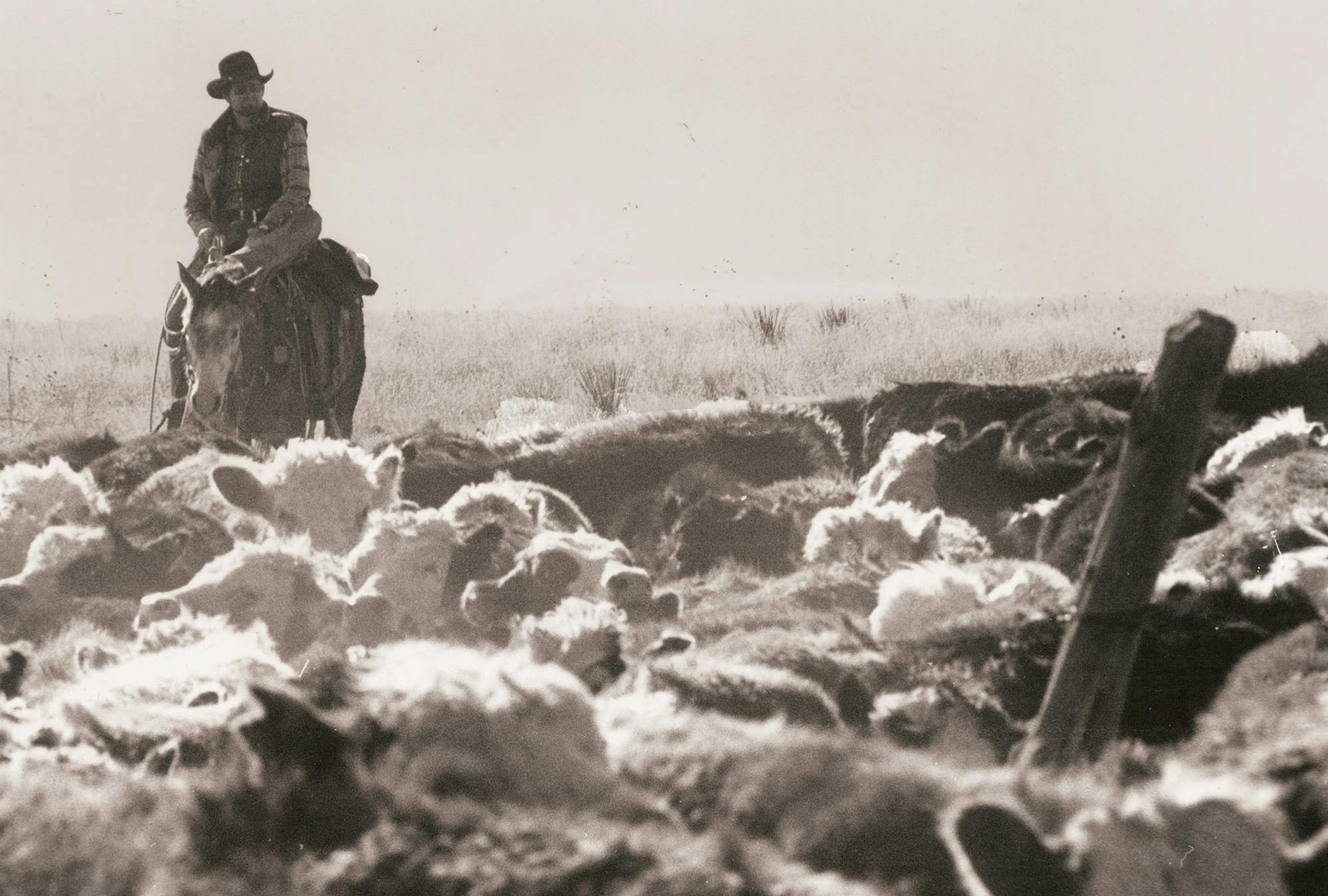
By the winter of 1982, Erickson was 39 years old and had been trying to make it big as a novelist for 15 years. To keep his family afloat, he had tended bar at the Perryton golf club, worked at a feedlot, part-timed as a handyman, hawked a board game he had invented called Blitz Chess, and, for 8 years, eked out a living as a working cowboy while he collected those refusals. But the cattle market had crashed the year before, in 1981, and though he had since found work as a carpenter’s helper, Erickson was nearly broke.
He had two young children by then, with another on the way. The family was living in a small house in Perryton. Kris drove a beat-to-hell Ford Pinto and hadn’t bought a new dress in years. But there were glimmers of hope.
His prose had started to change: instead of trying to mimic the writers on the best-seller lists (nowadays he describes those early efforts as “hopeless, depressing, existential, postmodern flapdoodle”), he had started to write in the style his cowboy companions used when they told stories at roundups and spring brandings. He had discovered his “cowboy voice” and was beginning to find a small audience. Livestock Weekly had given him a column about his life on horseback. The University of Nebraska Press had published two of his books about cowboying. And then he thought he’d gotten his biggest break yet, when, at the Western Writers of America conference, he met Irwyn Applebaum, an editor at Bantam Books, which published the best-selling Western author of all time.
“Louis L’Amour was at the end of his life, and he had been the workhorse for Bantam Books,” Erickson says. “He’d sold about a hundred million copies for them, and they were beginning to wonder what they were going to do after Louis died or couldn’t write anymore. So I got acquainted with his editor. I thought it looked pretty promising—that I was very close to getting a contract with Bantam.”
One brutally cold day, with eight inches of snow on the ground, Erickson shivered his way through his carpentry work until he could get home to check the mailbox, as he did every evening. That night, there was a letter from Bantam Books inside. He ripped it open. The letter began: “We’re sorry to inform you . . .” Erickson felt the world fall away beneath him. “I had gone through hundreds of rejection letters,” he says, “but that one was a killer.” He woke up early the next morning to write, but he didn’t feel right. He was light-headed and dizzy. He went back to bed and slept for 24 hours straight. He had horrible dreams. He was wounded, struggling to trudge through snow, a crimson trail of blood in his wake. He was being followed by yellow-eyed wolves. “I actually thought I might die,” he recalls.
Instead, he got up early again the next morning, at 4:30 a.m. He went to his writing office nearby, opened his journal, and made a decision that would change his life.
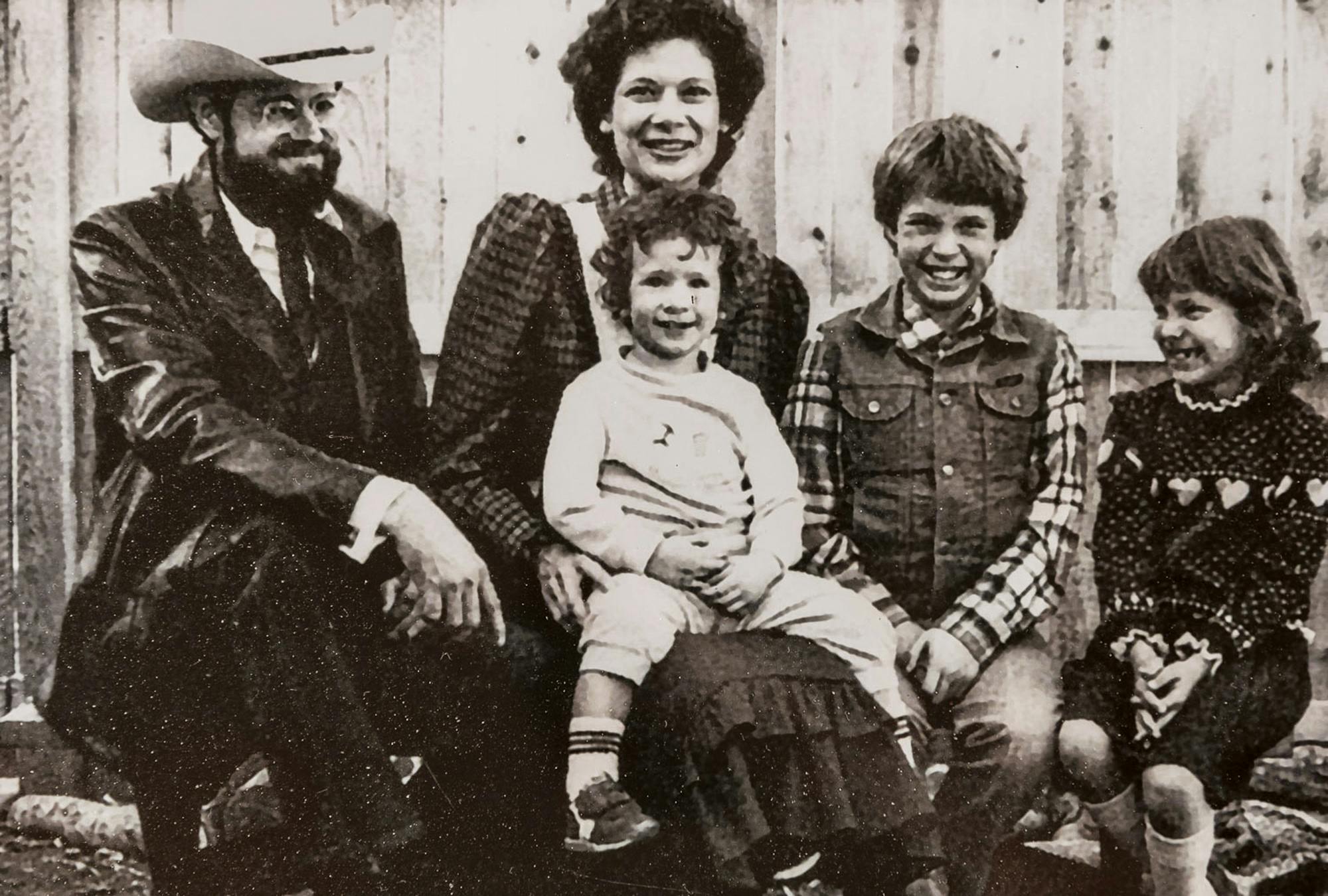
After Erickson shows me his childhood home, we drive about a block and a half and pull up to a detached two-car garage. Cream paint is flaking off the building, and weeds are growing through cracks in the driveway. “Kind of run-down,” Erickson says, shrugging. We are staring at the birthplace of Hank the Cowdog.
This garage was where Erickson went that winter morning in 1982, after he received the rejection letter from Louis L’Amour’s editor. With those dreams of yellow-eyed wolves still fresh in his mind, he ran some numbers. His total income from writing over the last fifteen years came to about $3,000. Calculating four hours of work a day, he figured he’d earned about 13 cents an hour.
He recognized that his early stuff hadn’t been very good, but he was certain that his more recent work deserved a wider audience. He knew that if he didn’t figure something out, he would be forced to quit writing, just as he had been forced to quit cowboying when the cattle market tanked. That morning, Erickson decided to throw a Hail Mary. “I didn’t need the approval of editors or agents in New York,” he says. “I needed readers.” He’d print his own dang books.
This, of course, was before the internet enabled anyone who can upload a file to grow a wide audience as a self-published author. To make matters worse, Texas was suffering the toughest oil bust in state history, and almost all of the few small presses in Texas were going belly-up. Nevertheless, with the support of his father and Kris, Erickson borrowed $2,000 from “a foolish banker” and founded Maverick Books. He turned his garage into company headquarters, found a printer in Michigan, and sent off a manuscript. On September 1, 1982, he went to the freight dock in Perryton and picked up 1,600 copies of The Devil in Texas and Other Cowboy Tales.
The book was a collection of wry short stories about ranch life in the Panhandle. Some stories recounted his days in the saddle. Others veered toward the fantastic and philosophical: one imagines Satan challenging two cowpokes to a roping contest, to which one cowboy responds, “Hell against Texas is a normal day around here.” Erickson placed ads for the book in Livestock Weekly, in which he listed his home phone number and address for direct sales. Then he went on the road peddling copies of The Devil in Texas, at rodeos, feed stores, 4-H auctions, saddle shops, goat ropings, and county fairs.
There was indeed an audience for the kind of Western stories Erickson wrote. The same readers who bought Louis L’Amour were now buying John R. Erickson. The first run of The Devil in Texas sold out quickly. Erickson ordered a second printing, and that sold out too. By Christmas, Maverick Books had sold some five thousand copies of the book, to the tune of $35,000.
Tucked away among the fourteen stories in The Devil in Texas was one called “Confessions of a Cowdog.” It had first appeared in the June 1981 issue of The Cattleman. Earlier that year, Erickson had been contracted to write twelve articles for the Fort Worth–based magazine. When he had run out of ideas, he decided it might be fun to try writing from the perspective of a well-meaning but meddlesome Australian shepherd, Hank, that he had known on a ranch near Forgan, Oklahoma.
“I didn’t consider the first Hank story the best of those that were in The Devil in Texas,” Erickson says. When he did readings, he most often read a story called “Diary of a Bronc.” But one day he switched things up and read “Confessions of a Cowdog” to the Rotary Club in Perryton. “The audience just roared with laughter,” he says. “After the program, a local optometrist came trotting out and said, ‘John, you need to do more with that dog.’”
Erickson was surprised. “It never occurred to me there was anything special about that story,” he says. But when he read the cowdog story to other groups, he kept hearing the same thing: “More Hank.”
Erickson wasn’t sure he could stretch the cowdog idea beyond the story he had already written, but given the warm reception, he figured he would try giving Hank his own short novel. He wrote the first three chapters in three days, but then he got stuck. He drove out to the LZ Ranch, the last place he’d worked as a cowboy. His old companion, Tom Ellzey (the inspiration for the rancher High Loper) was still living there. Ellzey listened while his friend read, using a different voice for each of the characters. “He laughed so hard tears were running down his cheeks,” Erickson remembers. “He said, ‘You’ve gotta finish that book.’”
The next day, he went back to his garage and started chapter four, “The Boxer.” The chapter includes one of the most iconic scenes of the series, in which Hank and Drover taunt another dog, a boxer, by marking his owner’s truck tires. Erickson finished what he called “Hank the Cowdog and the Chicken House Murders” a while later. As she typically does with Erickson’s work, Kris read the draft and gave him feedback. He made edits, then sent the manuscript to a typesetter in Omaha, Nebraska, who suggested he drop “and the Chicken House Murders” from the title. Erickson allowed the cut, and in March 1983, Maverick Books published The Original Adventures of Hank the Cowdog.
He published a sequel and then a third Hank book. “It took me fifteen years of writing to stumble into the Hank story,” Erickson says. “I was not looking for Hank.” When he first began writing Hank stories, he adds, children weren’t even the intended audience.
That changed when he got a call from the school librarian in the nearby tiny town of Spearman, asking him to come read Hank to her elementary students. “And I said, ‘I can do the program, but they won’t understand the humor. I’m giving my best chops as a writer to these stories.’ And she said, ‘Well, my kids are bringing their parents’ books to school and reading them at recess. And they’re laughing, and they think they understand humor.’”
The librarian was right. “I enjoyed working with the kids, and they laughed at all the right places,” Erickson says. Hank had found his market.
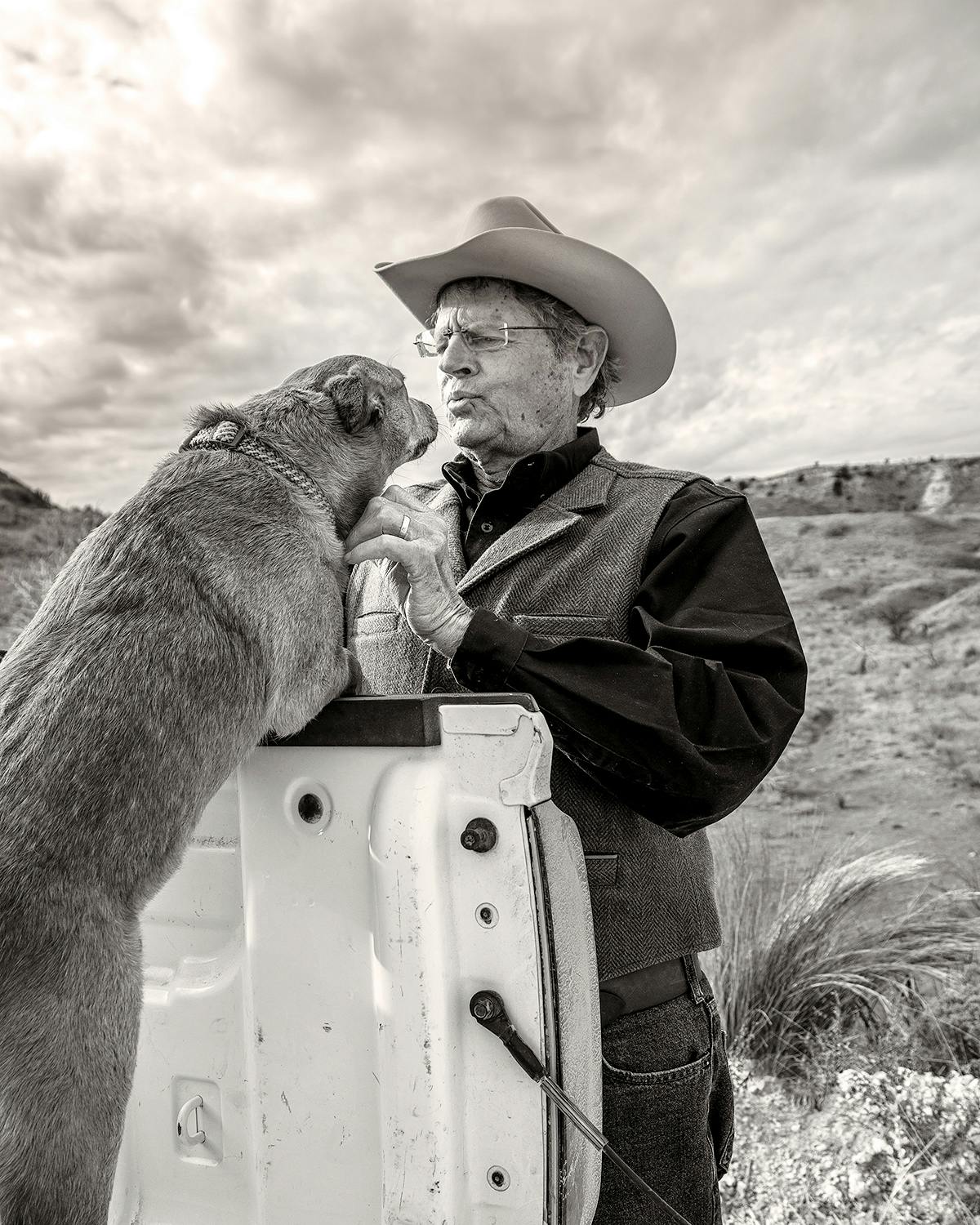
Several miles southeast of Perryton, Erickson steers his truck off the tortilla-flat caprock into a sea of grassland. Tall cottonwoods, hackberry trees, and Chinese elms grow in clusters along the banks of a snaking creek. Cattle graze in the pastures on summer-yellow grass. It’s nearly three in the afternoon, and warm but not too hot for Texas in July. Erickson seems perfectly in his element.
He points to a house several hundred yards from the road: the LZ Ranch, where he first ended his cowboy career. In the Hank books, he says, when he describes the features of the ranch in Ochiltree County—the actual Texas county that includes Perryton—“the house, the yard, the gas tank, the feed barn, machine shed, corrals, and Emerald Pond, the overflow from the septic tank” are all modeled after the LZ Ranch.
Every Hank story has a few things in common. They all begin with, “It’s me again, Hank the Cowdog,” and most end with, “Case closed.” Every book comprises twelve chapters. All but the latest volume feature playful black-and-white sketches by Gerald Holmes. (He died in 2019; Nikki Earley, who works for Maverick Books, has since taken over the illustrations.)
In addition to Hank and Drover, characters include High Loper and his wife, Sally May. The couple has a little boy named Alfred and a baby daughter named Molly. Elsewhere on the ranch, you’ll find cowboy Slim Chance (High Loper’s right-hand man), Pete the barn cat (Hank’s mortal enemy, naturally), and J. T. Cluck (the head rooster). Hank’s world is full of critters: coyotes and buzzards, a fiddle-playing fox, a witchy owl, a mean bobcat, and a beautiful collie named Beulah, whom Hank dreams of while snoozing on his gunnysack.
Thrumming in the background, just behind Hank’s high jinks, are Erickson’s values—courage, accountability, hard work, respect for rural folks and their labor, and a devotion to family—but these are not doled out with a heavy hand. Sometimes Hank learns a valuable lesson; sometimes he doesn’t. The humans in Hank’s world do attend church on Sundays, but while Erickson’s faith informs everything he writes, he never preaches in his books. Instead, he focuses on spinning a good yarn, one that will make him laugh. “People have been laughing at their dogs for ten thousand years,” he says. “My stories only tell about my little piece of the world, which I’ve tried to learn as deeply as I can. But they’re honest and really funny.”
Like the real cowdog on which he’s based, Hank is constantly getting tangled up in trouble, either because of his boneheadedness or Pete the barn cat’s scheming. There’s almost always some sort of mystery to be solved. To some extent, Hank is a canine parody of Sherlock Holmes, dashed with the swagger of John Wayne and the comedic timing of Laurel and Hardy. Hank is a fountain of malapropisms, he loses track of his thoughts, and he often embellishes his stories to outlandish proportions. But for all his flaws (and fleas), when a one-eyed killer studhorse or a hooking bull puts someone in danger, Hank bravely charges into battle. And no matter how serious a pickle Hank gets into, he always comes through all right. Because every Hank story also has this in common: a happy ending.
The same is not always true of life on a ranch. And four years ago this coming spring, Erickson was standing in the ashes of his little piece of the world, with no way of seeing how he might find his own happy ending.
On March 6, 2017, strong winds damaged a power line near the Ericksons’ ranch, sparking the third-largest fire in state history. Erickson was no stranger to wildfires. In 2006, he had helped fight another massive blaze that came dangerously close to his place. He had realized then that under dry conditions, the cedars and elms growing in Picket Canyon could be a death trap. The Ericksons had been lucky that time, but the next time the wind was not in their favor.
As smoke nearly blotted out the sun, they fled the canyon with John’s two laptops (on which several Hank books were saved), Kris’s mandolin, and the clothes on their backs. The fire would go on to burn some 318,000 acres across four counties, including 90 percent of the pastures on the M-Cross. A young man died in Lipscomb County, and a separate fire in nearby Gray County killed three people. When Erickson and Kris returned the day after their evacuation, parts of the ranch were still burning. The fields were wastelands of blackened trees and scorched grass. They found the remains of several cattle and a horse, but no trace of their beloved blue heeler, Dixie. Their home was a smoldering wreck of charred wood. There was little to salvage, but in the ash, Erickson found his custom spurs, the word “Hank” shining in silver against the soot.
Friends and neighbors flocked to Erickson’s side. They mended fences and delivered feed for the surviving cattle. Soon, word got out to Hank fans. Donations began to stream in from across the country. One boy from southeastern Louisiana persuaded his dad to deliver a flatbed full of hay to the ranch. A girl from Lubbock sent Erickson a $10 gift card to Dairy Queen with a note saying that an M&M Blizzard might help Hank feel better. So many letters and packages poured in that three years later Erickson has yet to get through them all. Most wanted to know: “Did Hank make it?”
Erickson wasn’t sure he had. For several days, he felt disoriented. He was unable to write on his usual schedule. “After the fire, I worried that, with my life and routines in such a jumbled state, Hank might have gotten lost, and that when I knocked on his door, he might not show up,” Erickson later wrote. “Even though I have been writing Hank books for 35 years, I have never known if he would answer my knock.”
Eventually, he forced himself back into his old habits. And then one day he typed those six words: “It’s me again, Hank the Cowdog.” One year after the Perryton blaze, Erickson published book 71, The Case of the Monster Fire. Hank had answered the knock.

The first time we spoke on the phone to discuss this story, Erickson was wary. “I don’t want to wind up a dead coyote hanging on the fence,” he told me. When we meet, he explains his initial hesitation: “I don’t want to be part of a snotty little article about an old white guy who goes to church.”
He says that a conservative cowboy writer like himself has reason to be suspicious of news outlets and entertainment companies. And he has long resisted compromising his principles for opportunities that might have brought him more fame and money. “I’ve always had a stubborn streak,” he says. “I think it’s natural to people in West Texas. Those who aren’t don’t get past the first dust storm.”
Hank’s first brush with Hollywood came in May 1985, when CBS created a stand-alone half-hour cartoon based on the original book, featuring the actor who voiced Captain Kangaroo as the narrator. Erickson was thankful for the national exposure, but he was also troubled by what he saw on the screen. The writers had altered his story in subtle but important ways: for instance, they had omitted the family and turned the cattle ranch into a chicken farm.
“I’m lucky that I found a character that people latch on to without having to go through the indignity of having him made into a Saturday morning cartoon series or a television soap opera or something,” Erickson says. “I don’t know how to explain the popularity of the Hank stories, but I’m very grateful that it’s turned out that way. I don’t know what I did to deserve that gift, but I got it and it’s my job to see that nobody cheapens it.”
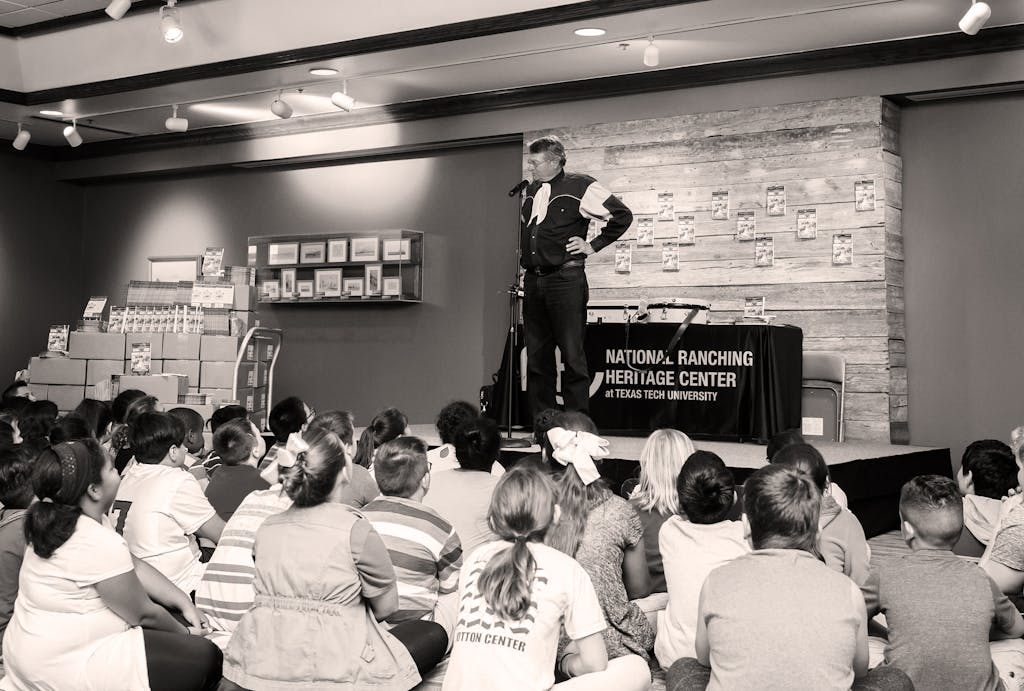
Over the years Disney came calling; so did Nickelodeon. But Erickson was protective of the rights to Hank. In recent years, Erickson’s youngest son, Mark, has taken the reins on Hank adaptations. In 2015, Mark spent several months in New Zealand working with an animation group on a pilot for a Hank series, but they never found a distributor.
Then Jeff Nichols came along. The Austin-based screenwriter and director—best known for the critically acclaimed films Take Shelter, Mud, and Loving—took to Hank while reading book eleven, Lost in the Dark Unchanted Forest, to his five-year-old son. He wrote a podcast script based on the book and Erickson loved it, calling it “warm, funny, faithful to the spirit of the Hank stories, and respectful to our audience, the people who ‘brung us to the dance.’” In addition to casting Matthew McConaughey as Hank, Nichols gathered a posse of A-listers, including Kirsten Dunst, Cynthia Erivo, Jesse Plemons, and Michael Shannon, to voice the other characters in the podcast. Erickson voices Wallace, a buzzard.
The humor of the Hank books is what first drew Nichols to the project. “I could be reading it to my son and he’s laughing. And I’m laughing too,” Nichols says. He cites a scene in book eleven, quoting some lines verbatim, in which Hank and Drover are eating their cheap, dry dog food out of a hubcap. Hank is trying to think, but Drover’s loud chomping distracts him.
HANK: Do you suppose you could be a little quieter in chewing your food?
DROVER: Well, I don’t know, Hank. It’s pretty hard.
HANK: Of course it is. It’s always harder to eat with manners than to eat with the wild abandon of a hog, but who wants to sound like a hog?
DROVER: Not me.
HANK: Hogs make no pretense at being civilized, Drover. They crunch and smack and grunt, and nobody cares because they’re only hogs who eat like pigs.
DROVER: That makes sense.
HANK: But we’re not hogs, Drover. We aspire to something higher and better. We try to bring a certain air of dignity to the ritual of eating. The act of imposing dignity on the chaos of experience is called civilization, and protecting civilization has always been hard.
DROVER: Yeah, but I meant the kernels were hard.
“It just made me laugh,” Nichols says. “And I thought, ‘There’s a real mind here behind this.’”
Despite having fans like Nichols, Erickson hasn’t exactly been welcomed by the state’s literary elite. He mentions a time when Larry McMurtry (who wrote the foreword for Erickson’s 1980 book Panhandle Cowboy) shrugged him off at a banquet they attended at Tarleton State University, and the time Larry L. King refused to acknowledge him while they sat at a table together, signing autographs at the Texas Book Festival. But he stopped caring about what the literati thinks of him a long time ago. “I made the decision I wanted to hang out with readers and not writers,” he says.
Those readers cut a wide cross section, but Erickson is especially happy that Hank tends to resonate with kids who aren’t natural bookworms—just as he wasn’t. “That’s all the legacy a guy should need or want,” he says.
Now the writer who wanted to be Hemingway is happy to be the guy who writes Hank. He takes his fans and his responsibility to them seriously. “I get letters from families who have read the books on the deathbed of a child,” he tells me. “When you hear that, you need to remove your shoes, because you’re on holy ground. It probably sounds kind of silly, but it’s a bond of trust that we have with our readers. On the simplest level, it’s, ‘We’ll never give your children anything that’s poisonous.’ That seems to me a reasonable expectation for literature.”
All of Erickson’s other work lives in Hank’s shadow, though he has written 25 other books: nonfiction texts, a couple of biographies, a fine West Texas history, and a few novels. This year, he has two nonfiction books coming out with Texas Tech University Press, one about the wildfires and the other about Panhandle archaeology, one of Erickson’s passions.
By some measures, Erickson has surpassed most of the authors he had once tried to emulate. “I don’t have any regrets about what I’ve done. I have a pretty clear conscience. I sleep well at night,” he says. “So what a deal.”
Before I leave the M-Cross, Erickson takes me out in his open-top ATV to show me parts of the ranch that are inaccessible by truck. Erickson is behind the wheel. I am riding shotgun on the bench seat. So is Rosie, who alternates between panting in my ear, drooling on my jeans, and snapping at any soapweed that dares get too close. We drive up steep canyons and descend crumbling embankments of sun-bleached limestone. Turkey vultures circle overhead and wild plums bloom in red bunches.
At one point as we drive along, Erickson moves to change gears. A praying mantis has taken up residence on the ball of the stick shift. He tries to move the insect to the dash, but the little guy climbs up onto his knuckles instead. Erickson doesn’t bother shooing him away. By the time we pull up to the house, Rosie has crawled into his lap, a fly has settled on his shoulder, and two grasshoppers have roosted on his pant leg. The mantis is still perched on his hand. He looks like some sort of Panhandle Dr. Dolittle—or maybe like Slim Chance, out for a ride with his cowdog.
This article originally appeared in the March 2021 issue of Texas Monthly with the headline “King of the Canine Canon.” Subscribe today.
